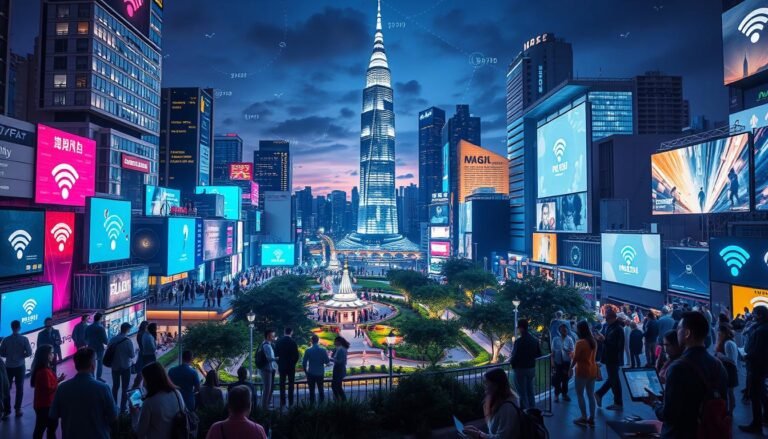Consumerism and Its Effects on Society
Have you ever thought about how your shopping affects the world? In today’s society, consumerism drives many things, from our personal lives to the economy. It’s all about buying more and more, which changes our culture, values, and the planet.
Consumer culture started after World War II and grew with the Industrial Revolution. Now, it’s a big part of our lives, making us think that having more stuff makes us happy. This has led to economic growth but also worries about its effects on society.
The United States is a great example of a country driven by consumerism. It has brought economic success but also problems with using resources too much. If everyone lived like Americans do, we’d need three planets to support us all.
We’ll look into how consumerism affects our social lives, relationships, and the planet. We’ll see how ads make us want more and talk about ways to be more mindful consumers. We’ll also look at ethical consumerism and minimalism as alternatives.
Key Takeaways
- Consumerism shapes modern society, affecting economics and culture
- Overconsumption leads to unsustainable resource use
- Consumer behavior is influenced by advertising and lifestyle goals
- Consumerism impacts social relationships and personal well-being
- Alternative approaches like ethical consumption are gaining traction
- Balancing consumption with environmental concerns is crucial
Understanding Consumerism: Definition and Origins
Consumerism deeply affects our modern world, shaping how we act and driving growth. It has roots in history and still deeply impacts our society today.
What is Consumerism?
Consumerism believes that buying more goods and services is always good. It links spending to economic growth. This view became more popular in the mid-20th century, showing how capitalism improves our lives.
Historical Development of Consumer Culture
The industrial revolution started consumerism. In the U.S., production soared from 1860 to 1920:
| Year | Production Increase | Population Increase |
|---|---|---|
| 1860-1920 | 12 times | 3 times |
This big increase in production meant more goods needed to be bought. By 1929, a government report found people wanted more goods and services than ever before. This set the stage for today’s consumerism.
Key Factors Driving Consumerism
Several things help consumer culture grow:
- Advertising: Companies promote products to make people want them.
- Planned obsolescence: Products are made to quickly go out of style.
- Social status: Buying things helps people feel better about their social standing.
These factors change how we act and help the economy grow. But, this growth also brings problems like harming the environment and changing our values.
“The conscious and intelligent manipulation of the organized habits and opinions of the masses is an important element in democratic society.” – Edward Bernays, pioneer in public relations
The Economic Impact of Consumerism
Consumerism is a big deal in today’s economy. It makes up about 70% of the U.S. GDP through spending. This shows how crucial what people buy affects the economy’s health.
Consumer spending is really powerful. The latest numbers show a 5.4% price hike from June 2020. This is the biggest increase since the 2008 Great Recession. It shows how much people spending drives demand.
Consumerism does more than just move numbers around. It changes what companies make and how they plan. For example, more people are buying SUVs, while sales of small cars are down. This shows how what people want affects what’s available.
| Economic Indicator | Impact of Consumerism |
|---|---|
| GDP Composition | Consumer spending contributes 70% |
| Inflation Rate | 5.4% increase (June 2021 vs June 2020) |
| Auto Industry Trend | Shift towards SUVs, decline in small cars |
Consumerism helps the economy grow, but it also has its downsides. If everyone consumed like Americans do, we’d need five Earths to support it. This shows we need to grow the economy in a way that’s good for the planet and our resources.
Consumerism and Its Effects on Society
Consumerism has changed our society in big ways. It has touched many parts of our lives, from how we live together to our personal connections. This shift has made things more complex and far-reaching.
Social Stratification and Inequality
Consumerism has made the gap between the rich and the poor bigger. In 2005, a huge 59% of the world’s resources went to just 10% of the wealthiest people. This shows how our desire for more stuff can make economic gaps worse.
Changes in Cultural Values
Consumerism has changed what we value in our culture. The American Dream used to mean equal opportunities for all. Now, it’s more about making a lot of money and having the latest stuff. This change shows how we see success and happiness tied to what we own.
Impact on Personal Relationships
How we connect with others has changed because of consumerism. We often look for happiness and identity in buying things. This can make us unhappy and always want more, as studies from 2000 showed.
“Consumerism paradoxically presents the notion of freedom and free choice for consumers but may enslave them to a cycle of consumption.”
Living in a world driven by buying and selling is important to understand. We need to see how it affects us and our communities.
Psychological Effects of Consumerism
Consumerism deeply affects our mental health and happiness. Research shows a complex link between materialism and happiness. Some people find joy in buying things, but others feel more anxious and depressed.
Studies find that those with strong materialistic values often feel less satisfied with life. This is especially true for young adults who have grown up in wealthier times than their grandparents. Yet, materialists with higher incomes can be almost as happy as those who don’t focus so much on buying things.
Family plays a big part in shaping our views on materialism. Teens from less supportive homes or those from divorced families tend to value material possessions more. This shows how important a supportive family is in teaching us to value things in a healthy way.
“The unhappiest people are often those with high prosocial and high materialistic values.”
Long-term studies show that chasing financial goals can make people less happy over time. After 20 years, those with big financial dreams often feel less fulfilled. This means focusing on buying things might make us feel worse and cause mental health issues.
Consumerism also changes how we see the environment. As we value material possessions more, we care less about the planet. This shift has big effects on our future and the health of Earth.
Environmental Consequences of Overconsumption
The environmental impact of overconsumption is clear. Our planet faces big challenges because of the high demand for resources and bad practices.
Resource Depletion and Scarcity
The global population’s growth puts a lot of pressure on our resources. By 2030, we’ll need 50% more food and energy, and 30% more freshwater to prevent shortages. Right now, 38% of the world’s ice-free land is used for food production. This will increase by 60% by 2050.
Pollution and Waste Management
Our way of living creates a lot of waste. One-third of all food made globally is thrown away each year, with nearly half lost before it even reaches us. This waste leads to pollution and takes away from our efforts to be sustainable.
Climate Change Implications
Overconsumption is a big factor in climate change. Fossil fuels and farming make up over 30% of greenhouse gas emissions. The livestock industry alone is responsible for 14.5% of all emissions. These numbers show we need to change how we consume things.
| Resource | Current Use | Projected Increase by 2050 |
|---|---|---|
| Food Production | 38% of ice-free land | 60% increase |
| Meat Production | 229 million tonnes (2000) | 465 million tonnes |
| Global Resource Extraction | 1.7x regeneration rate | Continued unsustainable growth |
These numbers show we really need to change how we consume things. We must adopt sustainable practices to lessen the environmental harm caused by overconsumption.
The Role of Advertising in Fueling Consumerism
Advertising shapes how we think and act as consumers. It makes us believe that buying things will make us happy. This has led to more spending, affecting our economy and the environment.
Brands have a huge impact on us. We see thousands of ads every day, from TV to social media. This constant bombardment changes what we buy, with half of us making choices based on ads.
Social media has changed how ads work. Sites like TikTok and Instagram let us buy things right from our screens. This easy shopping has made us buy more, especially the young.
“Social media advertising has been on the rise, with businesses allocating a substantial portion of their marketing budget to platforms like Facebook, Instagram, and Twitter.”
Advertising also harms the environment. Every year, 1.5 million tons of paper are used for ads like flyers. This waste harms the air and uses up resources, showing we need better ways to advertise.
Advertising helps the economy but raises big questions. Ads for beauty products can make people feel bad about themselves. Fast fashion encourages us to buy more, which is bad for the planet.
But, people are starting to think differently about buying things. This change offers brands a chance to be more kind to the planet and to us. They can match what we value more deeply.
Materialism and the Pursuit of Happiness
Many people think that buying lots of stuff will make them happy. But research shows it’s not that simple. Some find happiness in buying things, while others find it in other areas of life.
Material Possessions and Well-being
Research has found a link between wanting lots of stuff and feeling unhappy. A study in 2014 showed that wanting more things can actually make you less happy. This means buying lots of stuff might not bring the happiness we think it will.
Shifting Values: Intrinsic to Extrinsic Goals
Our values have changed from focusing on personal growth and relationships to wanting more wealth and status. This change affects how happy we feel as a society.
“86% of Americans believe today’s youth are too focused on buying and consuming things.” – The Harwood Group
This fact shows a big worry about young people and their love for buying things. It makes us think about how this affects their happiness and society. We need to think about what we really want in life, balancing what we buy with what truly makes us happy.
| Generation | Characteristics | Impact on Well-being |
|---|---|---|
| Millennials & Gen Z | Grew up with sense of entitlement | Higher risk of depression |
| Grandparents’ Generation | Less affluent upbringing | Slightly higher happiness levels |
The table shows how different generations deal with wanting lots of stuff and how it affects their happiness. It’s clear that wanting happiness through buying things is a complex issue in our lives and society.
Consumerism in the Digital Age
The digital age has changed how we shop and interact with brands. E-commerce and digital marketing have made online shopping more popular. This has led to fewer people visiting physical stores and worries about local businesses.
Fast fashion is another big change. It’s made shopping cheaper and quicker, but it also creates pollution and waste.
Social media has a big impact on what we buy. Sites like Instagram shape how we think about products. People spend a lot of time on these platforms, seeing ads and idealized lifestyles.
Studies show that spending more time on Instagram means buying more things we don’t really need. This is because we’re driven by feelings, not just needs. Products are linked to our emotions, making us want them more.
“The fight for controlling customer data and shaping consumer decisions is becoming crucial in the industry.”
Marketers are adapting to what consumers want. A Salesforce report says most people want offers that feel personal to them. They also want fast delivery, expecting quick results from their online buys.
But, digital shopping isn’t all good. A McKinsey survey found most people don’t trust businesses that don’t protect their data well. With more AI and chatbots in e-commerce, there’s a risk to our privacy.
The digital age brings both good and bad changes to consumerism. We need to find a balance between the perks of online shopping and being ethical and caring for the planet.
Alternative Approaches: Ethical Consumerism and Minimalism
New paths are appearing as we face the issues of too much consumerism. Ethical consumerism and minimalism show us how to live and consume better.
The rise of conscious consumption
Ethical consumerism is becoming more popular. In the UK, spending on ethical products has jumped from 17 billion to over 141 billion pounds since 1999. This shows more people are thinking about sustainable ways to consume.
A 2023 Deloitte report found that one in three UK consumers stopped buying some products because of ethical or sustainability reasons.
Embracing minimalism as a lifestyle choice
Minimalism is a big change from traditional consumerism. It’s about having fewer things and valuing quality over quantity. This way of living helps the planet by making less waste and promoting careful thinking about what we buy.
Minimalists choose to own only what brings them joy or is really useful. They don’t follow every new trend.
By choosing ethical brands and a minimalist lifestyle, we can live better and happier lives. This change is good for us and helps our planet.
Source Links
- Consumption and the Consumer Society
- The effects of living in a consumer society
- How the world embraced consumerism
- Britannica Money
- A Brief History of Consumer Culture
- Chapter 8 Consumption and the Consumer Society
- How consumer perceptions can affect the economy
- Consumerism: Definition, Economic Impact, Pros & Cons
- What are the Effects of Consumerism on Society?
- Effects of Consumerism
- Consumerism–Consumerism and its discontents
- Consumerism and Mental Health
- Consumerism and Climate Change: How the Choices You Make Can Help Mitigate the Effects of Climate Change | United Nations
- How Overconsumption Affects the Environment and Health, Explained
- The Negative Effects of Advertisement and the Potential Solution – Michigan Journal of Economics
- Consumerism and Social Media
- The Role of Advertising: The Impact on Society – Liftupmarketing
- The Problematic Role of Materialistic Values in the Pursuit of Sustainable Well-Being
- Why Materialism Is Impacting Your Happiness and Success
- Philosophical Reflections on Consumerism in the Digital Age
- The New Age of Consumerism – Consello
- Consumption in the Digital Age : Fashion Revolution
- Understanding Conscious Consumerism
- Minimalism vs. Consumerism: Finding Balance in a Materialistic World







